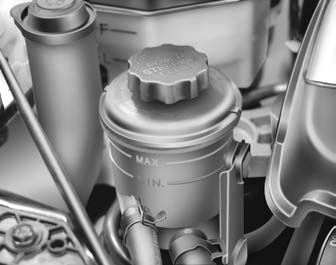Power steering

Checking the power steering fluid
level
With the vehicle on level ground, check
the fluid level in the power steering reservoir
periodically. The fluid should be
between MAX and MIN marks on the
side of the reservoir at the normal temperature.
Before adding power steering fluid, thoroughly clean the area around the reservoir cap to prevent power steering fluid contamination.
If the level is low, add fluid to the MAX level.
In the event the power steering system requires frequent addition of fluid, the vehicle should be inspected by an authorized Kia dealer.
NOTICE
• To avoid damage to the power steering
pump, do not operate the vehicle
for prolonged periods with a low
power steering fluid level.
• Never start the engine when the reservoir tank is empty.
• When adding fluid, be careful that dirt does not get into the tank.
• Insufficient fluid can result in increased steering effort; excessive noise may also be present as the steering wheel is turned.
• The use of the non-specified fluid could reduce the effectiveness of the power steering wheel and cause damage to it.
Use only the specified power steering
fluid. (Refer to "Recommended
Lubricants" later in this section.)
Power steering hose
Check the hoses and hose connections
for leaks or damage before driving the
vehicle.
See also:
Interior lights
Room light
Front (map light)
The lights are turned ON or OFF by
pressing the corresponding switch.
Center (dome light)
➀ DOOR : The light turns on or off
when a door is opened or clos ...
Mirrors
Outside rearview mirror
Be sure to adjust mirror angles
before driving.
Your vehicle is equipped with both
left-hand and right-hand outside
rearview mirrors. The mirrors can be
adjusted remotely ...
Fuel filler lid
1. Stop the engine.
2. To open the fuel filler lid, pull the
release lever.
CAUTION
To avoid injury from sharp
edges, it is recommended that
protective gloves be worn if
there is a need to op ...


